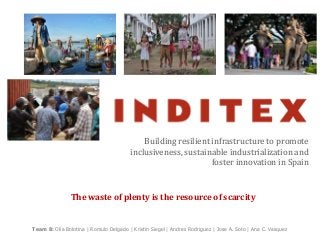
Redefining Textile Industry’s Recycling Process
- 1. Building resilient infrastructure to promote inclusiveness, sustainable industrialization and foster innovation in Spain Team 8: Olia Bolotina | Romulo Delgado | Kristin Siegel | Andres Rodriguez | Jose A. Soto | Ana C. Vasquez The waste of plenty is the resource of scarcity
- 2. THE PROBLEM 70%Of world population uses second hand clothes 191 T-Shirts every year. The average American throws away 10.5M tons are sent to landfills. 17 - 20% Industrial water pollution comes from textile industry. the carbon footprint of that fancy T-shirt you are wearing is estimated to be around 6 Kg
- 3. THE DESIRED OUTCOME OF THE PROPOSAL THE PROBLEM OBJECTIVE | IMPACT PROPOSAL STAKEHOLDERS EVALUATIONIMPLEMENTATION Environmental Impact • Reduction of : • CO2 emission • Water usage • Raw materials used Social Impact • Creation of new jobs • Increased awareness of environmental and social issues Company Impact • New stream of revenue • Enhanced image / brand Presence in 88 markets in all five continents, with upwards of 6,683 stores and 137,054 employees1
- 4. BREAK POLLUTION CYCLE BY REUSING, REPAIRING AND RECYCLING THE PRODUCT THE PROBLEM OBJECTIVE | IMPACT PROPOSAL STAKEHOLDERS EVALUATIONIMPLEMENTATION Bin Landfill Pollution Reuse Repair Recycle Transport New Markets Raw Materials Collecting Points
- 5. THE PROBLEM OBJECTIVE | IMPACT PROPOSAL STAKEHOLDERS EVALUATIONIMPLEMENTATION Z Recycle Reuse Repair 4/7 people are more likely to shop at a business if they know it is hosting a textile recycling bin Extend the life cycle of clothes, allowing emerging economies to acquire a premium brand at an affordable price. Ship clothes that require minimal changes to local designers and merchants in the emerging country that would repair and resell those clothes in their markets. Sort out the clothes by fiber and color. Shred into reclaimed fiber that can either be used for non-woven textile and/or stuffing, or blended with stable fiber and spun into yarn. WIN-WIN RELATIONSHIPS Happy customers that walk-out with vouchers for their contribution That are supported by a sustainable model without disrupting local economies fostering entrepreneuriship Thriving Economies New sustainable revenue stream for Inditex BREAK POLLUTION CYCLE BY REUSING, REPAIRING AND RECYCLING THE PRODUCT
- 6. INDITEX STAKEHOLDER MANAGEMENT THE PROBLEM OBJECTIVE | IMPACT PROPOSAL STAKEHOLDERS EVALUATIONIMPLEMENTATION
- 7. RECYCLE, REUSE AND REPAIR FEEDBACK LOOPS New MarketsIndustry Reuse & RepairRecycle Ecological Impact Reports Qualitative Customer Surveys Customer Loyalty Index Inventory Alert System Sorting THE PROBLEM OBJECTIVE | IMPACT PROPOSAL STAKEHOLDERS EVALUATIONIMPLEMENTATION
- 8. METRICS TO ASSESS SUCCESS AND EVALUATION THE PROBLEM OBJECTIVE | IMPACT PROPOSAL STAKEHOLDERS EVALUATIONIMPLEMENTATION Environmental Impact Metrics • Reduction of greenhouse gas emissions • Water footprint • Amount of raw materials used • Energy usage Social Impact Metrics • Number of newly created jobs in the recycling process • Number of people at the bottom-of the-pyramid served Company Impact Metrics • Budget spent on recycling R&D and innovation • Revenue stream from new markets • Cost savings All stakeholders in the system need to work together and act in union to solve the global problem.
- 9. Thank You!
Notes de l'éditeur
- Industria de Diseño Textil, S.A. (Inditex): - multinational clothing company, headquarter in Spain - one of the world’s biggest fashion retailer - 8 brands (e.g. Zara, Massimo Dutti) - Over 6,460 stores worldwide. Participant of the United Nations Global Compact 1 http://www.inditex.com/en/our_group/international_presence
- Cost savings due to less energy used and less raw material needed for the production of garments.
